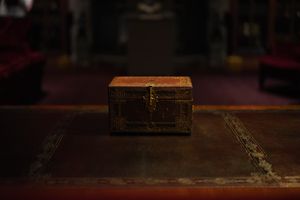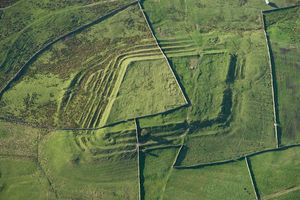Milestones Museum's costumed volunteer David P. Whithorn discusses his archaeological background and how he uses objects and an extensive historical knowledge to help families understand the story of their ancestors.
Introduction
I studied Archaeological Sciences at the University of Bradford in the early 1980s. I spent time in a radiocarbon dating lab as well as excavations on Viking, Roman and Medieval sites. Perhaps one of the most interesting periods was spent as a Finds Assistant, working on the Mary Rose in the year the ship was raised, 1982, almost 40 years ago...
However, underlying this was a much deeper interest in the Great War, 1914-18, which has lasted a whole lifetime. Since retiring, I have worked as a costumed volunteer at Milestones Living History Museum in Basingstoke, portraying that WW1 Tommy with a whole range of items and stories to help educate visitors of all ages about the War to end War.
But now, developing and building on the archaeological skills I acquired long ago does comes in very useful to expand and communicate the historical evidence from this long-ago conflict. Museum visitors tell me ‘My great-grandfather was killed, but I do not know anything about what happened...’. It doesn’t take much, a name, a medal, a family story however twisted, I will find them and tell their story.
Here, I present three examples of how such ‘archaeological’ artefacts and existing records can be extended, with such a deep knowledge, to provide new information in a way museum visitors could not imagine...
Part One
Field finds

A good friend took part in an organised metal-detecting survey of some former WW1 military camps around the city of Winchester. He gave me these items from the ‘scrap bucket’. The 1914 British General Service and 1918 US Army tunic buttons might have been expected, there were many such. The cartwheel object proved a mystery – but actually this is a ventilation grill from inside a 1914 Wolseley (Pith) helmet, many of these too were found.
However, it was the two broken and bent spoons that would prove to be the most interesting for me. Still quite visible were the crudely stamped lettering that would not only identify the regiments and hence the probable time these items had been lost at Winchester, they had the all important regimental numbers that would identify the individual soldiers that once had owned them.
1 LEN 9314

Thomas Hinchey was a pre-war soldier in the 1st Leinster Regiment. At the outbreak of war in August 1914, they were based in Fyzabad, India, but returned to England on 16/11/1914 and were moved to Morne Camp, Winchester, before going off to France on 19/12/1914. Clearly, Thomas Hinchey lost his spoon whilst at Morne Camp in Nov/Dec 1914! Thomas’s service records have not survived, but it is known that he made it home. However, from this point, it is possible to investigate each and every of the actions his battalion took part in and hence what Thomas was involved in through their war diary.
2 RI 9903
Here there is a mystery, that requires a little military detective work to sort out. The ‘2 RI’ refers to the 2nd Bn Royal Irish ‘....’, however the missing part could be Rifles or Regimen’. Soldiers’ numbers in the Great War were issued by the regiment and were not unique! Thus here are the two possible candidates:
i) 9903 Pte Thomas Rogers of the Royal Irish Rifles

Here there is a very different story. Thomas Rogers’ service records have survived. He joined the army in December 1916 from his home in Ireland (the Northern part, after Independence). However, very shortly afterwards, the War Office received a letter from his parents. Evidently, Thomas had added two years to his age when he had enlisted, he hadn’t been 18, but 16. That summer of 1916, during the Battle of the Somme, there had been an outcry (even reaching Parliament) about the numbers of boys who had joined up under-age and now had been killed on the Somme. Following the receipt of this letter, the War Office had immediately issued instructions that Thomas be held where he was. He would not be returned to his parents, but held in training and on Home Service until he attained his 19th birthday. Given the desperate circumstances in which Britain found herself in the weeks following the beginning of the German Spring Offensive in March 1918, Thomas was finally sent to France shortly after his 18th birthday. Sadly, from his records, it was not possible to determine if or when Thomas was at Winchester to narrow down the timeline that he lost his spoon. As with Thomas Hinchey, from here it would be possible to determine the locations and actions in which Thomas Rogers served with his battalion. He too would return safely home.
However, Thomas Rogers, from other records never served with the 2nd Bn RI Rifles but ONLY the 1st Bn from 1918. It would seem unlikely this broken spoon once belonged Thomas Rogers of the Royal Irish Rifles.
ii) 9903 Pte Timothy Murray of the Royal Irish Regiment

Records indicate that Timothy Murray served with the 1st (Garrison) battalion of the RI Regiment. At first glance, this might then seem to rule him out as the original owner of the spoon too, as here there is no link to a 2nd Bn RI Regiment either!
Looking further, this battalion was formed on 2/8/1915 in Dublin and arrived at Holyhead on 28/8/1915. They then sailed from Devonport on 6/9/1915 en route for Gallipoli. They arrived at Mudros on 24/9/1915. The battalion was moved across to the Gallipoli peninsula to take part in actions at Suvla Bay. I could find no detailed records for their activities and little more for Timothy Murray himself. However, it is evident that Timothy was wounded on the peninsula and transported back to the 16th Stationary Hospital on Mudros where he died of his wounds on 2/12/1915, he was buried here. Beyond that he had a wife, Bridget, and children. I could find no more.
The 1st Garrison Battalion, in Dublin 1915, had been made up from older soldiers of the regiment no longer in their prime - men who had been with the regiment for many years, previously serving with the 1st and 2nd‘Line battalions both at home and overseas.
Timothy Murray had owned this spoon for a very long time, since he was originally a member of the 2nd Bn RI Regiment - maybe as one who had sailed away on the Britannic in December 1899 to South Africa to take part in the Anglo-Boer War 1899-1902? A spoon is a soldier’s most personal possession – it is what he eats with. After many years, Timothy Murray lost his in August/September 1915 whilst in camp at Winchester en route for Devonport. What was left of it has been found now and a soldier who never came home, buried in a very forgotten foreign field has been remembered once more.
If you have enjoyed Culture on Call and you are able to make a donation, any support you can give will help us keep people connected.



